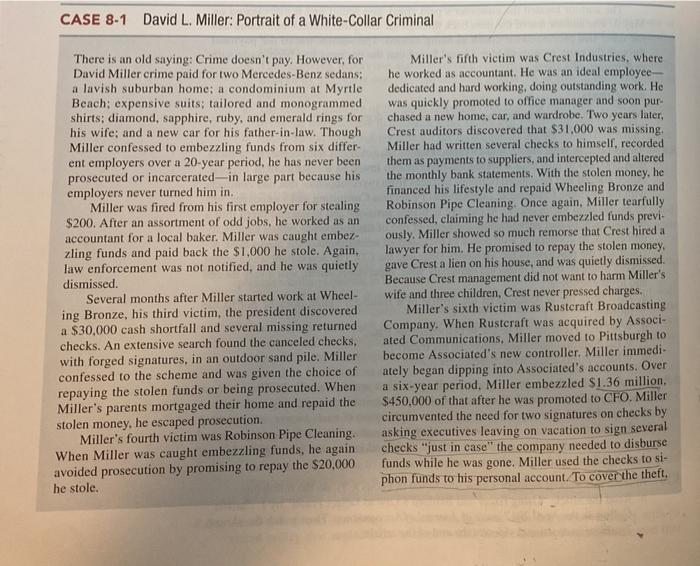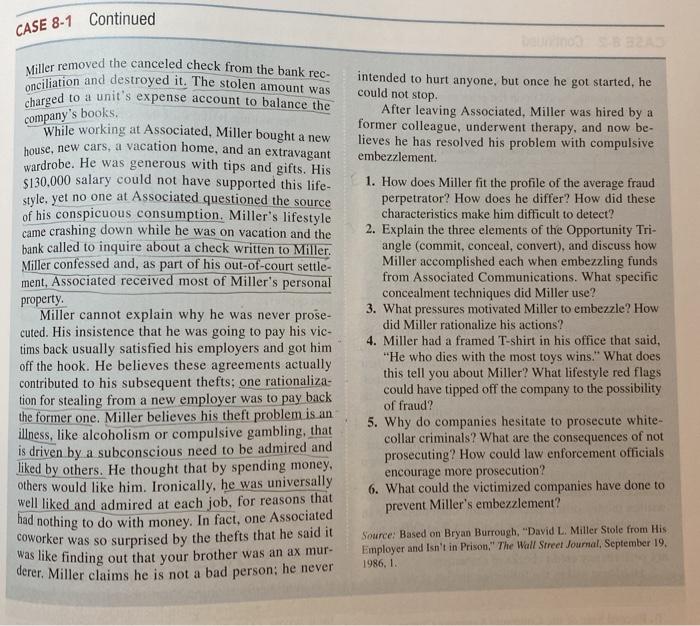Answered step by step
Verified Expert Solution
Question
1 Approved Answer
Clarification on question 1 CASE 8-1 David L. Miller: Portrait of a White-Collar Criminal There is an old saying: Crime doesn't pay. However, for David


Clarification on question 1
CASE 8-1 David L. Miller: Portrait of a White-Collar Criminal There is an old saying: Crime doesn't pay. However, for David Miller crime paid for two Mercedes-Benz sedans: a lavish suburban home; a condominium at Myrtle Beach: expensive suits: tailored and monogrammed shirts: diamond, sapphire, ruby, and emerald rings for his wife, and a new car for his father-in-law. Though Miller confessed to embezzling funds from six differ ent employers over a 20-year period, he has never been prosecuted or incarcerated-in large part because his employers never turned him in Miller was fired from his first employer for stealing $200. After an assortment of odd jobs, he worked as an accountant for a local baker. Miller was caught embez. zling funds and paid back the $1,000 he stole. Again. law enforcement was not notified, and he was quietly dismissed. Several months after Miller started work at Wheel- ing Bronze, his third victim, the president discovered a $30,000 cash shortfall and several missing returned checks. An extensive search found the canceled checks. with forged signatures, in an outdoor sand pile. Miller confessed to the scheme and was given the choice of repaying the stolen funds or being prosecuted. When Miller's parents mortgaged their home and repaid the stolen money, he escaped prosecution. Miller's fourth victim was Robinson Pipe Cleaning. When Miller was caught embezzling funds, he again avoided prosecution by promising to repay the $20,000 he stole. Miller's fifth victim was Crest Industries, where he worked as accountant. He was an ideal employee dedicated and hard working, doing outstanding work. He was quickly promoted to office manager and soon pur chased a new home, car, and wardrobe. Two years later, Crest auditors discovered that $31,000 was missing, Miller had written several checks to himsell, recorded them as payments to suppliers, and intercepted and altered the monthly bank statements. With the stolen money, he financed his lifestyle and repaid Wheeling Bronze and Robinson Pipe Cleaning. Once again, Miller tearfully confessed, claiming he had never embezzled funds previ- ously. Miller showed so much remorse that Crest hired a lawyer for him. He promised to repay the stolen money, gave Crest a lien on his house, and was quietly dismissed Because Crest management did not want to harm Miller's wife and three children, Crest never pressed charges. Miller's sixth victim was Rustcraft Broadcasting Company. When Rusteraft was acquired by Associ- ated Communications, Miller moved to Pittsburgh to become Associated's new controller. Miller immedi- ately began dipping into Associated's accounts. Over a six-year period. Miller embezzled $1.36 million. $450,000 of that after he was promoted to CFO. Miller circumvented the need for two signatures on checks by asking executives leaving on vacation to sign several checks "just in case the company needed to disburse funds while he was gone. Miller used the checks to si- phon funds to his personal account. To cover the theft. CASE 8-1 Continued intended to hurt anyone, but once he got started, he could not stop company's books, Miller removed the canceled check from the bank rec- onciliation and destroyed it. The stolen amount was charged to a unit's expense account to balance the While working at Associated, Miller bought a new house, new cars, a vacation home, and an extravagant wardrobe. He was generous with tips and gifts. His $130,000 salary could not have supported this life- style, yet no one at Associated questioned the source of his conspicuous consumption. Miller's lifestyle came crashing down while he was on vacation and the bank called to inquire about a check written to Miller. Miller confessed and, as part of his out-of-court settle- ment, Associated received most of Miller's personal property Miller cannot explain why he was never prose- cuted. His insistence that he was going to pay his vic- tims back usually satisfied his employers and got him off the hook. He believes these agreements actually contributed to his subsequent thefts: one rationaliza- tion for stealing from a new employer was to pay back the former one. Miller believes his theft problem is an illness, like alcoholism or compulsive gambling, that is driven by a subconscious need to be admired and liked by others. He thought that by spending money, others would like him. Ironically, he was universally well liked and admired at each job, for reasons that had nothing to do with money. In fact, one Associated coworker was so surprised by the thefts that he said it was like finding out that your brother was an ax mur- derer. Miller claims he is not a bad person, he never After leaving Associated, Miller was hired by a former colleague, underwent therapy, and now be- lieves he has resolved his problem with compulsive embezzlement 1. How does Miller fit the profile of the average fraud perpetrator? How does he differ? How did these characteristics make him difficult to detect? 2. Explain the three elements of the Opportunity Tri- angle (commit, conceal, convert), and discuss how Miller accomplished each when embezzling funds from Associated Communications. What specific concealment techniques did Miller use? 3. What pressures motivated Miller to embezzle? How did Miller rationalize his actions? 4. Miller had a framed T-shirt in his office that said, "He who dies with the most toys wins." What does this tell you about Miller? What lifestyle red flags could have tipped off the company to the possibility of fraud? 5. Why do companies hesitate to prosecute white- collar criminals? What are the consequences of not prosecuting? How could law enforcement officials encourage more prosecution? 6. What could the victimized companies have done to prevent Miller's embezzlement? Source: Based on Bryan Burrough, "David L. Miller Stole from His Employer and Isn't in Prison." The Wall Street Journal, September 19, 1986, 1 Step by Step Solution
There are 3 Steps involved in it
Step: 1

Get Instant Access to Expert-Tailored Solutions
See step-by-step solutions with expert insights and AI powered tools for academic success
Step: 2

Step: 3

Ace Your Homework with AI
Get the answers you need in no time with our AI-driven, step-by-step assistance
Get Started


